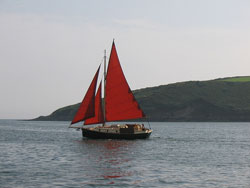| Browse by Categories |
|
 |
|
|
|
| |
|
Galway Hooker |
| |
| |
|
|
|
|
|
There are four types of Galway Hooker, namely
gleoiteog, púcán, leathbhád and bád mór. In the time before
trains and cars, transportation was a much more difficult
affair. The quickest route for news, goods, or people was
often by water. Hence, Galway, like any port town, drew its
wealth from the sea; both from fishing and from the
extensive trade it carried on with France, Spain, and the
West Indies. |
 |
|
|
None of this would have been possible without the
aid of a great fleet of ships, the like of which is seldom seen today. It was
one class of vessel, though, that came to distinguish itself as Galway's
signature upon the water. That craft was the Galway Hooker ; seen above on
Galway Bay.
These days, the Hookers appear annually at celebrations, such as the
Kinvara
festival of Cruinniú na mBád (Gathering of the Boats). A recent count of the
vessels showed 23 boats over 30ft to be riding the waves. An astonishing
accomplishment, considering nearly all of the original Hookers had left the
water by 1975. The flowing, characteristic sails of the boats are also captured
in the stylised fountain at the top of Eyre square, whose brown-red, rusty
curves serve to commemorate Galway's 500 years as a city and its deep maritime
heritage.
The name Hooker almost certainly comes to us from the Dutch; just which Dutch
word it is, is a matter of opinion. The term Hooker is known to apply to hook
and line fishing, whereas both howker and holker correspond to a small easily
maneuverable vessel. Whatever the truth may be, boats called Hookers also sail
from Holland to this day, although they are of different make than those of
Galway, and as these things are, we should be happy to almost know where the
term originated.
Where the distinctive design of the boats originated is considerably less clear.
Authorities on the matter have claimed lineage from a host of different
traditions; Norse and Cornish designs prominent among the speculations. This
notwithstanding, basically everyone is content to conclude that the boats,
wherever their ancestors sailed from, have been in Galway long enough to evolve
into something quite unique, and are rightly thought of as Galway's own
creation.
The Galway Hookers are subdivided into four types, with only the larger of the
two commonly invoking the name. The largest vessel, the Bád Mór (pronounced
'Bawd More), is 35 to 44 feet in length. The second largest, the Leath Bhád
(pronounced 'La Wawd'), or half-boat, has a hull length of roughly 32 feet. The
other two boats are the Gleoiteog and the diminutive Púcán.
The boats are often noted for their strong sharp bow and sides that curve
outward like 'the breast-bone of a water fowl', as Mary Banim once put it. The
design, built largely of oak, was sturdy, stable, and quick; allowing fisherman
from the Claddagh and
Connemara to navigate difficult passages, while hauling
cargo (usually fish) weighing upwards of 12 to 15 tons.
The Hookers were probably at their greatest presence in the Bay in the years
preceding the Great Famine, when the Claddagh was at its height. Indeed, several
reports from the period verify that the Claddagh fleet itself numbered at least
100 vessels; a number which clearly distinguishes Galway as the West's centre
for boat building. Sadly, famine, depleted fishing stocks, and the advent of
modern technology would eventually seal the Hooker's fate as a working vessel.
The story of Galway and the sea is one that goes back farther than the written
word. Nevertheless, it can easily be said that one of the greatest actors to
take the stage, in this maritime adventure, was the Galway Hooker. In its time,
the Hooker was like no other craft, and its clever design was fitted purposely
for the subtleties of Galway's waters. Literally thousands of lives were tied to
these great ships in life and in death, and as such, there could scarcely be a
more powerful emblem of this little village by the sea. |
|
|
|
|
|
|
